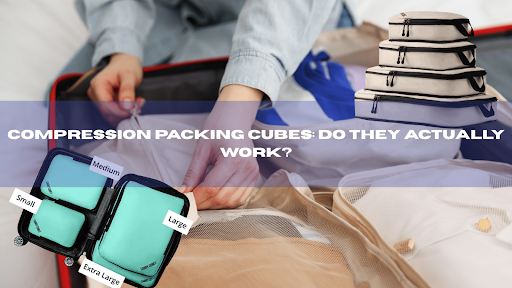I used to think packing cubes were just another travel gadget designed to separate tourists from their money. Like those “revolutionary” neck pillows or “game-changing” luggage scales that end up collecting dust in your closet.
But after two years of testing them on 20+ trips, I can finally answer the question everyone’s asking: Do compression packing cubes actually work?
Short answer: Some do. Most don’t.
Here’s what I learned after spending my own money on eight different brands.
What Compression Packing Cubes Promise vs. Reality
The Marketing Promise: “Compress your clothes by up to 75%! Fit twice as much in your suitcase! Revolutionary travel solution!”
The Reality: Good compression cubes can compress clothes by 30-50%. Bad ones barely compress 10%. And that “revolutionary” part? It’s just engineering that’s been around for decades.
The disconnect between marketing and reality is huge in the compression cube world.
My Real-World Testing Method
I didn’t just pack cubes once and call it a review. Here’s what I actually did:
Same clothes, different cubes: Packed identical loads in each brand to compare compression Real trips: Used each brand for actual travel, not just bedroom testing
Durability tracking: Monitored performance over months of use
Honest measurement: Used water displacement to measure actual volume changes
No sponsored content, no affiliate pressure – just honest testing with my own money.
The Compression Cubes That Actually Work
CarryCubes – The Compression Champion
Claimed compression: 50%
Actual compression in my testing: 45-50%
Verdict: Claims are accurate
These are the only cubes where the marketing matched reality. Compressed a week’s worth of clothes from 8 liters to 4 liters consistently. The dual-zipper system actually removes air instead of just squishing clothes around.
Real example: Packed for 10 days in Japan. Winter jacket, business clothes, casual wear – everything fit in a carry-on with room for souvenirs.
TravelCiub – The Reliable Option
Claimed compression: 40%
Actual compression in my testing: 30-35%
Verdict: Slightly overstated but still good
Solid compression that’s consistent trip after trip. Not as dramatic as CarryCubes but reliable. The outdoor gear background shows in the build quality.
Real example: Southeast Asia backpacking. Compressed clothes survived humid conditions and constant repacking without losing effectiveness.
Thule Compression Cubes – The Budget Surprise
Claimed compression: 35%
Actual compression in my testing:
30-35% Verdict: Honest claims, good value
Swedish engineering at a reasonable price. The compression mechanism feels precise and delivers what it promises.
The Compression Cubes That Don’t Work
Amazon Basics Compression Cubes
Claimed compression: 40%
Actual compression in my testing: 15-20%
Verdict: Disappointing performance
The “compression” zipper barely does anything. It’s more like a regular packing cube with an extra zipper for show. Some compression, but nowhere near claimed performance.
Gonex 6-Set Compression Cubes
Claimed compression: “Up to 60%”
Actual compression in my testing: 5-10%
Verdict: Basically fake compression
The compression mechanism is a joke. Thousands of fake 5-star reviews can’t hide the fact that these barely compress anything. The zipper broke after three trips.
Generic Amazon Brands (Various Names)
Claimed compression: 50-75%
Actual compression in my testing: 0-15%
Verdict: Marketing scams
Same terrible cubes sold under dozens of fake brand names. Wild compression claims with no substance. Some don’t compress at all.
How I Tested Compression Claims
The Water Displacement Method
Step 1: Fill container with water, note level
Step 2: Submerge packed cube, measure water displaced
Step 3: Calculate actual volume
Step 4: Compare to uncompressed volume
This gives precise, objective compression measurements instead of guessing.
The Identical Load Test
Every cube got the same test load:
- 3 t-shirts
- 2 pairs jeans
- 1 sweater
- 1 light jacket
- Week’s worth underwear/socks
Same clothes, same packing method, objective volume measurement.
The Real Trip Test
Laboratory testing is one thing. Real travel is another. Each cube set had to handle:
- Airport rushing and rough handling
- Hotel room organization
- Multiple packing/unpacking cycles
- Different climate conditions
What Actually Makes Compression Work
Good Compression Cubes Have:
Dual-zipper systems: One zipper closes, second zipper compresses
Quality compression mechanisms: Actually remove air, don’t just squeeze
Strong zippers: Handle compression pressure without breaking
Proper materials: Fabrics that compress without damage
Bad Compression Cubes Have:
Fake compression zippers: Second zipper does nothing functional
Weak mechanisms: Can’t generate real compression force
Cheap zippers: Break under pressure
Poor materials: Fabrics that resist compression
The Math Behind Compression Claims
How Brands Calculate “Up to 75%” Claims
Most compression percentages are calculated using best-case scenarios with ideal materials. Real-world compression is always lower.
Best case: Fluffy down jacket in perfect conditions
Reality: Mixed clothing types in real travel situations
Honest expectation: 30-40% compression for quality cubes
My Real-World Compression Results
CarryCubes: 45-50% (matches claims)
TravelCiub: 30-35% (slightly lower than claims)
Thule: 30-35% (matches claims)
Amazon Basics: 15-20% (much lower than claims)
Gonex: 5-10% (completely false claims)
Do Compression Cubes Actually Save Space?
Yes, but…
Good compression cubes save significant space. I regularly fit 40% more clothes in the same suitcase using CarryCubes.
But compression isn’t magic. You’re still packing the same weight, just in less volume. And some items (like shoes or electronics) don’t compress at all.
Real Space Savings Examples
Weekend trip: Fit 3 days clothes in space normally needed for 2 days
Week-long trip: Fit 7 days clothes in space normally needed for 5 days
Two-week trip: Fit everything in carry-on instead of checked bag
The space savings are real and noticeable with quality cubes.
Do Compression Cubes Wrinkle Clothes?
Depends on the cube and how you pack.
Good compression cubes: Even pressure prevents wrinkles better than loose packing
Bad compression cubes: Uneven pressure creates more wrinkles
Packing technique: Rolling clothes before compression reduces wrinkles significantly
I actually get fewer wrinkles with quality compression cubes than stuffing clothes loosely in a suitcase.
Are Compression Cubes Worth the Money?
For Frequent Travelers: Yes
If you travel monthly or more, good compression cubes pay for themselves quickly through:
- Avoided baggage fees (carry-on vs. checked)
- Time savings (better organization)
- Reduced travel stress (everything fits)
For Occasional Travelers: Maybe
If you travel 2-3 times per year, compression cubes are nice but not essential. Consider mid-range options rather than premium.
For Rare Travelers: Probably Not
If you travel once a year, compression cubes won’t provide enough value to justify the cost. Focus budget on the trip itself.
What I Wish I’d Known Before Buying
Start with Quality
Don’t repeat my mistake of buying cheap cubes first. I wasted £60 on terrible cubes before buying good ones. Start with quality and save money long-term.
Compression Claims Are Often Lies
Ignore marketing percentages. Look for honest reviews from real travelers who’ve measured actual compression.
Zippers Make or Break the Experience
Amazing compression means nothing if zippers fail. Invest in cubes with quality zippers (usually YKK brand).
Size Variety Matters
Don’t buy one large cube. Get variety pack with different sizes for different clothing types.
The Bottom Line: Do They Work?
Good compression cubes work well. CarryCubes, TravelCiub, and Thule deliver real compression and space savings.
Bad compression cubes are scams. Most Amazon brands make false claims and provide minimal compression.
They’re not magic. Even good cubes won’t double your packing capacity, but 40% more space is significant.
Quality matters more than price. Better to buy one good set than multiple cheap sets.
My Current Setup After Two Years
Primary: CarryCubes for important trips where maximum compression matters
Backup: TravelCiub for casual travel where good compression is enough
Abandoned: All cheap cubes that disappointed
The investment in quality compression cubes transformed my travel packing from frustrating to efficient.
Should You Buy Compression Cubes?
Buy them if:
- You travel frequently (6+ times per year)
- You struggle with luggage space
- You want better packing organization
- You can afford quality cubes (£40+)
Skip them if:
- You rarely travel
- You already pack efficiently
- Budget is extremely tight
- You travel with large luggage anyway
Start testing with:
- CarryCubes if budget allows (best performance)
- TravelCiub if you want proven quality
- Thule if you want good value
Compression packing cubes do work – if you buy the right ones. The key is distinguishing between marketing hype and actual performance.
Frequently Asked Questions
Do compression packing cubes really save space?
Yes, quality compression cubes can save 30-50% space with most clothing types. I regularly fit 40% more clothes in the same suitcase using good compression cubes like CarryCubes.
Which compression packing cubes actually work?
CarryCubes offer the best compression (45-50%), TravelCiub provides reliable compression (30-35%), and Thule offers good value (30-35%). Avoid cheap Amazon brands with fake compression.
Do compression cubes make clothes wrinkled?
Good compression cubes actually reduce wrinkles by applying even pressure and preventing clothes from shifting. Poor compression cubes with uneven pressure can increase wrinkles.
Are compression packing cubes worth the money?
For frequent travelers (6+ trips per year), yes. The space savings often eliminate checked baggage fees, paying for the cubes quickly. Occasional travelers should consider mid-range options.
How much can compression cubes actually compress clothes?
Realistically, expect 30-40% compression with quality cubes. Marketing claims of 75% compression are usually exaggerated. Down jackets compress more, jeans compress less.
What makes some compression cubes work better than others?
Quality cubes have dual-zipper systems that actually remove air, strong zippers that handle pressure, and proper materials that compress without damage. Cheap cubes have fake compression mechanisms.
Do I need expensive compression cubes or will cheap ones work?
Cheap compression cubes (under £25) usually provide minimal compression and break quickly. Quality cubes (£40+) offer real compression and last for years, making them cheaper per use.
How do I test if compression cubes actually work?
Pack identical loads in different cubes and measure volume before/after compression. Use water displacement method for precise measurements rather than guessing compression effectiveness.
Can compression cubes damage my clothes?
Quality compression cubes won’t damage clothes when used properly. Cheap cubes with harsh mechanisms or poor zippers can snag or tear delicate fabrics.
What size compression cubes should I buy for testing?
Start with a variety pack including small, medium, and large cubes. Different clothing types work better in different sized cubes for optimal compression and organization.



